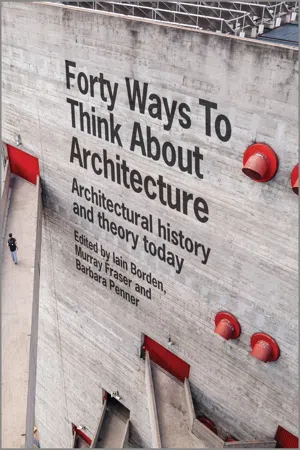
Forty Ways to Think About Architecture
Architectural History and Theory Today
- English
- PDF
- Available on iOS & Android
Forty Ways to Think About Architecture
Architectural History and Theory Today
About This Book
How do we think about architecture historically and theoretically? Forty Ways to Think about Architecture provides an introduction to some of the wide-ranging ways in which architectural history and theory are being approached today.
The inspiration for this project is the work of Adrian Forty, Professor of Architectural History at the Bartlett School of Architecture, University College London (UCL), who has been internationally renowned as the UK's leading academic in the discipline for 40 years. Forty's many publications, notably Objects of Desire (1986), Words and Buildings (2000) and Concrete and Culture (2012), have been crucial to opening up new approaches to architectural history and theory and have helped to establish entirely new areas of study. His teaching at The Bartlett has enthused a new generation about the exciting possibilities of architectural history and theory as a field.
This collection takes in a total of 40 essays covering key subjects, ranging from memory and heritage to everyday life, building materials and city spaces. As well as critical theory, philosophy, literature and experimental design, it refers to more immediate and topical issues in the built environment, such as globalisation, localism, regeneration and ecologies. Concise and engaging entries reflect on architecture from a range of perspectives.
Contributors include eminent historians and theorists from elsewhere – such as Jean-Louis Cohen, Briony Fer, Hilde Heynen, Mary McLeod, Griselda Pollock, Penny Sparke and Anthony Vidler – as well as Forty's colleagues from the Bartlett School of Architecture including Iain Borden, Murray Fraser, Peter Hall, Barbara Penner, Jane Rendell and Andrew Saint. Forty Ways to Think about Architecture also features contributions from distinguished architects, such as Tony Fretton, Jeremy Till and Sarah Wigglesworth, and well-known critics and architectural writers, such as Tom Dyckhoff, William Menking and Thomas Weaver. Many of the contributors are former students of Adrian Forty.
Through these diverse essays, readers are encouraged to think about how architectural history and theory relates to their own research and design practices, thus using the work of Adrian Forty as a catalyst for fresh and innovative thinking about architecture as a subject.
Frequently asked questions
Information
Table of contents
- Forty Ways To Think About Architecture
- Table of Contents
- Acknowledgements
- Introduction
- Future Imperfect
- CHAPTER 1 How To Write About Buildings?
- CHAPTER 2 Pevsner vs Colomina: Word and Image on the Page
- CHAPTER 3 Smooth and Rough: Tactile Brutalism
- CHAPTER 4 Homely Affinities
- CHAPTER 5 On Regeneration
- CHAPTER 6 Fresh Reactions to St Paul’s Cathedral
- CHAPTER 7 Photographs and Buildings (mainly)
- CHAPTER 8 Stirling’s Voice: A Detailed Suggestion
- CHAPTER 9 Carte Blanche?
- CHAPTER 10 Buildings: A Reader’s Guide
- CHAPTER 11 The City and the Event: Disturbing, Forgetting and Escaping Memory
- CHAPTER 12 The Most Modern Material Of Them All …
- CHAPTER 13 `Things that People Cannot Anticipate’: Skateboarding at the Southbank Centre
- CHAPTER 14 `Truth, Love, Life’: Building with Language in Prague Castle under Masaryk
- CHAPTER 15 Le Corbusier: Lies, Damned Lies and Statistics
- CHAPTER 16 During Breakfast
- CHAPTER 17 [American] Objects of [Soviet] Desire
- CHAPTER 18 Words and Buildings
- CHAPTER 19 Slow Hard Look
- CHAPTER 20 Topography, Biography and Architecture
- CHAPTER 21 Of Character and Concrete: The Historian’s Material
- CHAPTER 22 Spectres of Marx in City X
- CHAPTER 23 History by Design
- CHAPTER 24 Angel Place: A Way In to Dickens’s London
- CHAPTER 25 On ‘Sachlichkeit’: Some Additional Remarks on an Anglo-German Encounter
- CHAPTER 26 Double Vision
- CHAPTER 27 Modernism
- CHAPTER 28 Yes, And We Have No Dentists
- CHAPTER 29 Reyner Banham’s Hat
- CHAPTER 30 Situated Architectural Historical Ecologies
- CHAPTER 31 Objects
- CHAPTER 32 Richard Llewelyn Davies, 1912–1981: A Lost Vision for The Bartlett
- CHAPTER 33 Things Ungrand
- CHAPTER 34 'Minor’ Spaces in Officers’ Bungalows of Colonial Bengal
- CHAPTER 35 Memoirs of Adrian
- CHAPTER 36 All That Glitters
- CHAPTER 37 A Response to Words and Buildings
- CHAPTER 38 Material Culture: `Manchester of the East’, Le Corbusier, Eames and Indian Jeans
- CHAPTER 39 Mr Mumford’s Neighbourhood
- CHAPTER 40 Banyan Tree and Migrant Cities: Some Provisional Thoughts for a Strategic Postcolonial Cosmopolitanism
- Author Biographies
- Index
- Photo Credits
- EULA